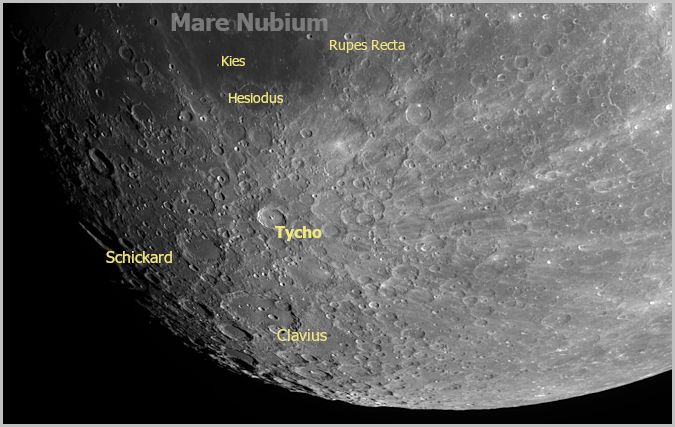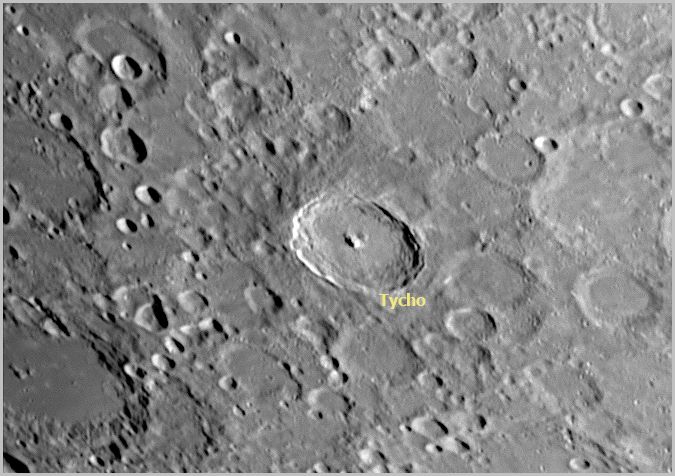In the southern region of the Moon around the crater Tycho
Thomas Grunge, 26. Dezember 2020

As at almost every end of the year, the clouds are bothering us. It is important to take advantage of every opportunity. On 25.12.2020 there was a short gap in the clouds. The waxing moon, moon age about 10.5 days, was favorable in the sky. That's why I took advantage of the situation to photograph the moon. Occasionally shreds of clouds passed through, between which I was able to record a moon video of 1000 pictures.
On closer inspection of the finished image, I notice many geological structures on the lunar surface, which I would like to briefly introduce. If you want to learn more about the geology of the moon, I recommend the following link at Wikipedia

TYCHO

To the south of the Moon is an extraordinary crater, the ray crater Tycho. With a diameter of 85 km, Tycho is actually only a medium-sized crater. Nevertheless, it towers above all other craters due to its widely extended rays that lead away from the crater rim in a star shape. The rays are relics of a violent impact of a meteorite about 10 km in size. The powerful meteorite compressed and melted the solidified lunar surface at the moment of impact, dispersing huge amounts of upward-firing matter as a bright, radial ejecta up to 1,800 km across the lunar surface. Of course, the enormous distances are also due to the low gravitational pull of the moon, which is only one-sixth of that of the earth. Due to its age of only 109 million years, Tycho is one of the youngest craters on the moon. The depth of 4,850 m is impressive, as is the central mountain with a height of almost 1,600 m. The strikingly bright crater is named after the Danish astronomer Tycho Brahe, who carried out particularly precise observations and calculations of the planetary orbits in Denmark and Norway at the end of the 16th century. [3]
Grabens and faults
Due to the lateral illumination of the moon, many geological formations emerge vividly in the area west of Tycho. They are mainly rilles (rima) and faults (rupes).
Straight grabens in particular have been created by geological faults and correspond to the tectonic rifts and rift valleys on Earth. They are usually several 1000 meters wide and hundreds of kilometers long. Their depth is up to 400 meters. [1]
Winding rilles are strongly reminiscent of terrestrial rivers, especially since they start in higher terrain and obviously follow the slope. However, since there was never liquid water on the moon, they most likely go back to lava flows, which are related to mare volcanism. Some of them are probably also lava tubes, the ceiling of which has collapsed in sections or completely. At the upper ends of these several 100-kilometer-long rilles, crater-like depressions are often found. [1]
Domes
These are small elevations in the smooth plains of the Moonmaria, which have a diameter of a few kilometers and are only a few hundred meters high. Since the structures are very flat, they cast only a relatively short shadow, which makes them difficult to observe. Unless they are close to the Terminator's day-night boundary.
RIMA HESIODUS

Rilles
In the north-west region around the crater Tycho is the Rima Hesiodus. A very large, straight rilles northwest of the crater Hesiodus, about 300 km long and 3 km wide. The course of the rilles is interrupted by some craters, such as crater Cichus N (8 km in diameter) in the middle of the rilles. It ends in the Palus Epidemiarum north of Capuanus.
RUPES RECTA / RIMA BIRT

Faults
Rupes Recta: Approximately 110 km long fault on the eastern edge of the Mare Nubium. The fault drops to the west about 300 m with an inclination of about 7°. It connects Thebit D in the north with smaller mountains in the south. In the current shot, the slope is in the shade. As the moon waxes, the disturbance appears bright, since bright material is deposited on the slope.
Rima Birt: Narrow curved Rilles about 50 km long and 1.5 km wide, which connects the elongated crater Birt E in the north with the crater Birt F (3 km diameter) west of crater Birt.
DOME KIES PI

One of the domes that are very easy to find is Kies Pi with a diameter of eleven kilometers. It is located in the Mare Nubium, west of the 44-kilometre-wide crater Kies, which is flooded with lava. Measurements of its shadow length showed that the cathedral is about 150 meters high. With very good observation conditions and excellent telescope optics, you may also be able to see its summit crater, which is just 1.3 kilometers in size. Individual domes such as Kies Pi are rare, because they usually occur in groups. [2]
Sources
[1] https://en.wikipedia.org/wiki/Rille
[2] https://studylibde.com/doc/11883543/dome-auf-dem-mond
[3] http://sternwarte-passau.de/?p=762